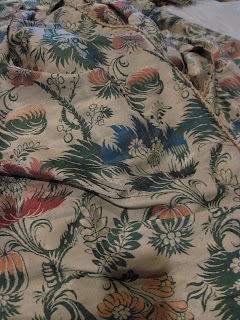I recently took a trip to Wethersfield, Connecticut to visit
the Webb Deane Stevens Museum and take the Textile Treasures-Digging Deeper
Tour. The day was one of the hottest and most humid of the year but that did
not deter the ladies that came with me!
We had made reservations and when we arrived we joined the
other ladies in the small museum shop (which had A/C) to wait for the start of
the tour. As there were 20 ladies signed up the group was divided into two and
each group looked at items in a different house before swapping places. Bearing
in mind the heat and humidity and the fact the house did not have A/C, just
fans, the items had been removed from their second floor settings to make it
more ‘comfortable’ to view them.
Our group started with the oldest pieces in the textile
collection, a bed covering thought to have been made in India, made of pieces
of embroidered fabrics joined together in no particular way. The designs were
flowers, birds and butterflies and the colours remained very bright. The
designs were worked in tiny chain stitches, most likely with a tamour hook, as
they were too tiny and even to have been worked with a needle.
The second piece was a silk dress of woven fabric which had
been re-made. Fabric was imported from the UK into the US prior to the
revolutionary war and so a silk fabric would have been very expensive and
dresses were often re-made to fit another family member. Again, the colour on
the fabric was still very bright.
Other pieces shown were items that were made using
crewelwork and several cross stitched samplers were on display along with
mourning pictures, stitched on water colour painted silk backgrounds.
Not too overcome by the heat in that room, the group moved
to the house next door, braving the heat outside, to view more items from the
collection. Here we saw a bargello stitched bag, a pincushion with the pins
spelling “March 17 1761” (these were often given as gifts to commemorate
events), another bed cover worked in wools, a few items of men’s clothing and a
beautifully stitched man’s pocket book that opened to reveal pockets for
masonic items. Several of the internal pockets were made from knitted pieces
rather than embroidered.
I urge you to check the websites of your local historical homes as quite often they have collections that they hide away for most of the time and then have special exhibits to share them with the public. Sometimes the advertising for these exhibits is not as good as it could be, but the items are so worth seeing up close and personal!









You have so much fun up in the north!!
ReplyDeleteWe try! We are staved of heirloom sewing shops so have to go looking for our 'eye candy' wherever we can!
ReplyDelete